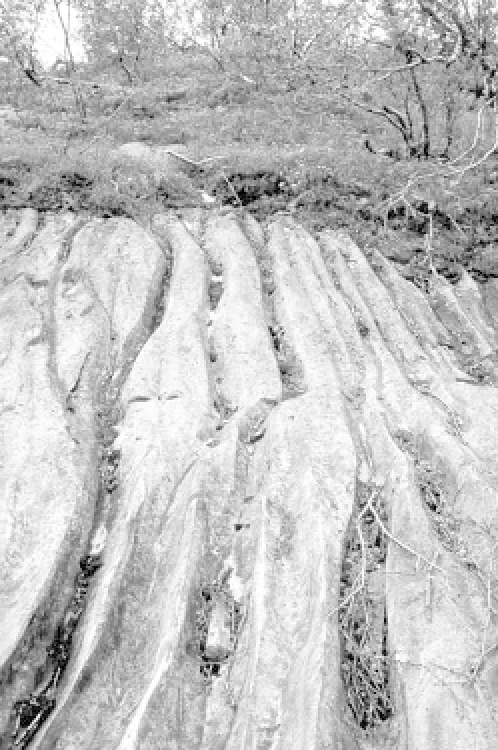Geology Reference
In-Depth Information
Plate 8.1 Rillenkarren
formed on a limestone block in a
Holocene landslide pile, Surprise Valley, near Jasper, Jasper
National Park, Alberta, Canada. The blocks are chaotically
orientated in the pile, but are rilled down the modern
drainage lines.
(
Photograph by Derek C. Ford
)
in diameter. Larger ones merge into
solution pans
.
They occur under soil and on bare limestone. Along
with shafts, they are the most widespread karren form.
Many are transitional to shafts. Solution pans or solu-
tion basins are small depressions shaped like basins or
dishes, usually with a thin cover of soil or algal or vegetal
remains. They are no more than 3 m wide and 0.5 m
deep, but many are much smaller. Some of the carbon
dioxide released by the decaying organic matter dissolves
in the water collected in the pans and boosts their dis-
solution. The Slav term for them is
kamenice
(singular
kamenica
), and the American term is tinajitas.
Undercut
solution runnels
(
Hohlkarren
) are like runnels in form
and size, except that they become wider with increasing
depth, probably owing to accumulated organic matter or
soil keeping the sides and base near the bottom damp.
Solution notches
(
Korrosionkehlen
) are about 1 m high
and wide and 10 m long. They are formed where soil
lies against projecting rock, giving rise to inward-curved
recesses.
Covered forms develop under a blanket of soil
or sediment, which acts like 'an acidulated sponge'
(Jennings 1971, 48). Where it contacts the underly-
ing limestone, the 'sponge' etches out its own array of
landforms, the chief among which are rounded solu-
tion runnels and solution pipes.
Rounded solution
Plate 8.2
Decantation runnels (
Rinnenkarren
) on marble
near Pikhauga Ridge, Svartisen, Norway.
(
Photograph by Derek C. Ford
)
runnels
(
Rundkarren
) are the same size as ordinary
runnels but they are worn smooth by the active cor-
rosion identified with acid soil waters. They are visi-
ble only when the soil or sediment blanket has been
stripped off (Plate 8.3, foreground). Cutters are soil-
covered clints that are widened at the top and taper
with depth (Colour Plate 2, inserted between pages
208 and 209).
Solution pipes
(or
shafts
or
wells
)are
up to 1 m across and 2-5 m deep, usually becom-
ing narrower with depth, but many are smaller. They
are cylindrical or conical holes, occurring on such soft
limestones as chalk, as well as on the mechanically
stronger and less permeable limestones. Solution pipes
usually form along joint planes, but in the chalk of
north-west Europe they can develop in an isolated
fashion.


